Spiders can be the subject of scientific fascination and the subject of nightmares. Their enchanting webs, dangerous venom, and offputting physical appearances make them infamous creatures that many people prefer to avoid. While many spiders can be harmful, like the black widow, most species are not a threat to your safety. This article will provide some background information on black widow spiders and present 6 spider species that look very similar to them. Here are 6 spiders that look like black widows, but are not.
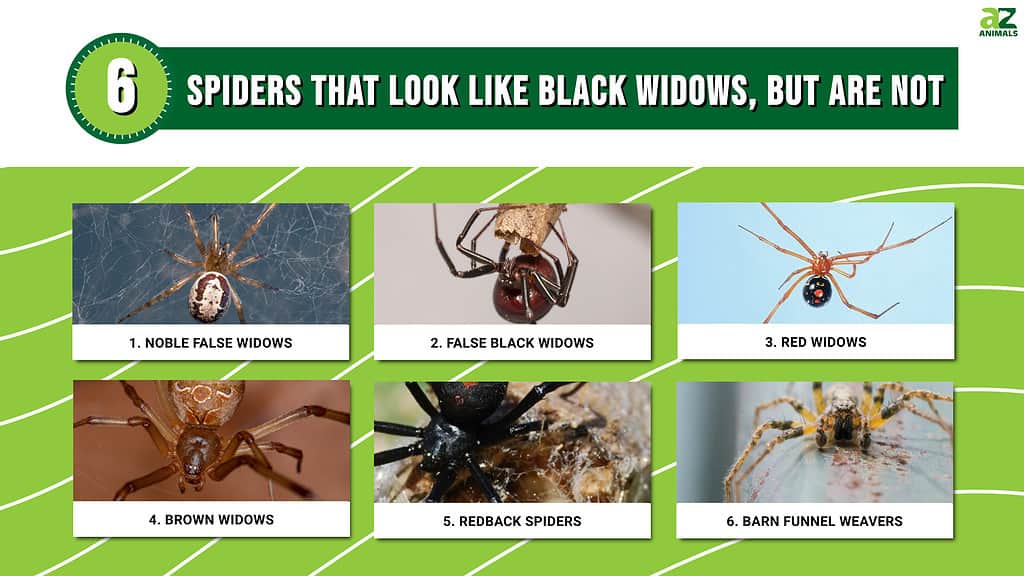
Black Widow Spiders

Southern black widows are the most fearsome species of black widow. This female is tending to an egg sac.
©Jeff W. Jarrett/Shutterstock.com
The name “black widow spider” broadly describes some members of the genus Lactrodectus. This genus includes “true widows” like southern black widows, northern black widows, western black widows, and European black widows. These spiders are infamous arachnids because of their venomous bite and striking appearance. They live in various parts of the world, with several species inhabiting North America. One of the most well-known species is the Southern black widow (Latrodectus mactans). It is recognizable by its glossy black coloration and a distinctive red hourglass-shaped marking on the underside of its abdomen. This red hourglass is a key identifier of the species. It serves as a warning signal to potential predators and humans alike.
Biology
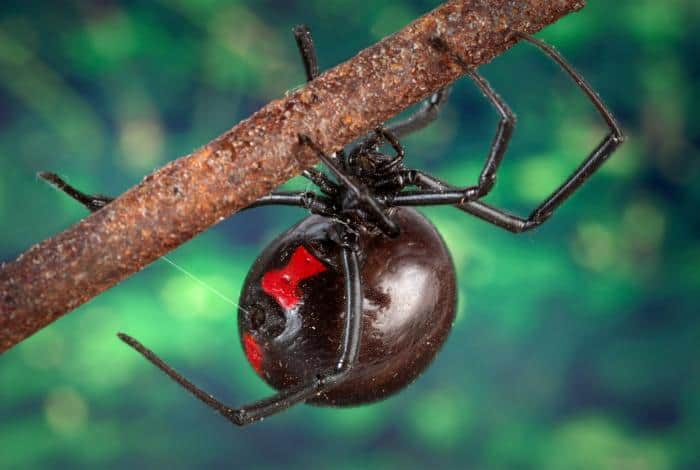
Southern black widows have red markings on their abdomen. They are located on their ventral (belly) side, not their back.
©James Gathany / public domain – License
Morphologically, southern black widow spiders exhibit sexual dimorphism, with females being significantly larger than males. Females typically measure around 1.5 inches in length, while males are much smaller, usually less than half the size. Their sleek and shiny bodies, with long, slender legs covered in fine hairs. The characteristic hourglass marking on the abdomen often accompanies red or orange spots or stripes on the ventral side. Males, on the other hand, possess more varied and intricate patterns but lack the iconic hourglass.
One of the most remarkable features of black widow spiders is their potent venom. The venom contains neurotoxins that affect the nervous system, causing intense pain, muscle cramps, and in severe cases, respiratory distress. Despite their fearsome reputation, black widow spiders are generally not aggressive. They only bite humans in self-defense or when they feel threatened. Bites are relatively rare and fatalities are even rarer, thanks to antivenom and medical treatment availability.
Diet
In terms of diet, black widow spiders are carnivorous predators, primarily feeding on insects and other arthropods. They use their silk to construct intricate, sticky webs. They position their webs in dark, sheltered locations, such as crevices, corners, or low-lying vegetation. When an unsuspecting prey item becomes ensnared in its web, the black widow quickly immobilizes it with a bite. The bite injects venom that liquefies the internal tissues of the prey.
Once the spider subdues its prey, the spider wraps it in silk to preserve it for later consumption. Black widows are patient hunters, and their silk not only serves as a means of capturing prey but also as a safety line. It can be useful in case they fall from their web or need to retreat from danger. Their diet consists primarily of insects like flies, beetles, and moths. However, they may occasionally capture larger prey, including other spiders. Black widow spiders play a vital role in controlling insect populations in their ecosystems. They are crucial to the balance of local arthropod communities and the greater community.
Distribution
The black widow spiders exhibit a diverse geographical distribution, with several distinct species found in various parts of the world. The northern black widow primarily inhabits the eastern and central regions of North America. Its range extends from the northeastern United States, such as New England, to parts of the Great Lakes region and southern Canada. This species is well adapted to temperate climates and can withstand colder conditions compared to its southern counterpart.
The infamous southern black widow lives throughout the southeastern United States, including states like Florida, Georgia, and Texas. Its range also extends to parts of Mexico and Central America. This species thrives in warm, humid climates and is recognizable by its prominent red hourglass marking.
The western black widow is primarily distributed across the western United States. Its range extends from the Pacific Northwest down to California and into parts of the southwestern states. This species is adapted to drier, arid environments and is often encountered in semi-arid regions.
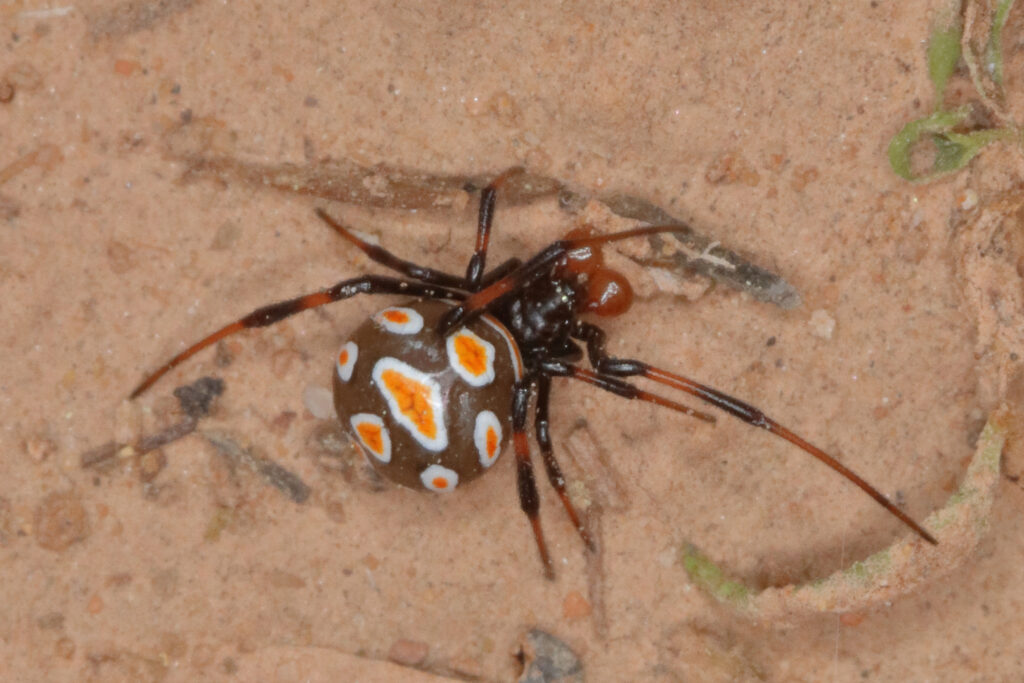
The European black widow is sometimes called the Mediterranean black widow.
©iStock.com/Frank Buchter
The European black widow is found in parts of Europe, North Africa, and the Middle East. Its distribution extends from the Mediterranean region into central and eastern Europe. This species is similar in appearance to its American counterparts, with red markings on its abdomen. However, it generally has multiple markings and is less venomous compared to the southern black widow.
#1 Noble False Widows
Description

The noble false widow spider is one terrifying spider, and it has the most potent venom of any spider in Ireland.
©JorgeOrtiz_1976/Shutterstock.com
The noble false widow (Steatoda nobilis), is a medium-sized arachnid resembling the true black widow but with some distinguishing features. They typically measure between 6 to 12 millimeters in length. Their body exhibits a dark brown to black coloration with a bulbous abdomen. One of their key identifying characteristics is the presence of cream-colored markings on their abdomen, which can vary in shape and intensity. Noble false widows are known for their shiny, robust bodies and have eight long, slender legs.
In terms of venom, the noble false widow does possess venom glands and is technically venomous. However, their venom is comparatively mild and is not considered dangerous to humans. A bite from a noble false widow may cause localized pain, redness, and swelling. However, severe reactions are rare and usually resolve without medical intervention. Despite their reputation, noble false widows are generally not aggressive and tend to flee rather than bite during a confrontation.
Distribution
The noble false widow spider is native to Madeira and the Canary Islands, but its range is expanding to various parts of Europe, including the United Kingdom and Ireland. In recent years, sightings have been reported in locations throughout Europe, likely due to human activities such as international trade and transportation. This spider’s ability to adapt to a range of climates enables it to establish populations in urban and suburban areas, where it can live in and around buildings, gardens, and other human-made structures.
#2 False Black Widows
Description

False widow spiders are dangerous to humans but not life-threatening.
©Dan Olsen/Shutterstock.com
The false black widow, also known as the cupboard spider (Steatoda grossa), is a common arachnid with distinctive physical characteristics. These spiders typically measure between 6 to 10 millimeters in body length. They have a dark, shiny brown or black coloration and often display a bulbous abdomen. One of the key identifying features of the false black widow, like the noble false widow, is pale, cream-colored markings on its abdomen, which can vary in shape but often resemble a faint hourglass or chevron pattern.
While the false black widow does possess venom and is technically venomous, its bite is generally mild and not dangerous to humans. The symptoms of a false black widow bite typically include localized pain, redness, and swelling, which usually resolve without medical treatment. These spiders are not known for aggressive behavior and are more likely to retreat than to bite when encountered by humans.
Distribution
The false black widow has a broad geographical distribution, making it a familiar presence in many regions. Originally native to Europe, it has been introduced to various parts of the world through global trade and transportation. This species can now be found in North America, South America, Australia, and other temperate and subtropical regions. In these areas, false black widows often thrive in human-made structures, including homes, sheds, and gardens, where they spin their webs to catch insects. This adaptability to urban environments has contributed to their wide distribution, as they can readily exploit the shelter and prey sources provided by human habitats.
#3 Red Widows
Description

The red widow spider is very uncommon and sports red markings that may look similar to southern black widows.
©Florida Division of Plant Industry Archive / CC BY 3.0 US, via Wikimedia Commons – License
The red widow spider (Latrodectus bishopi) gets its name from the striking red or reddish-orange coloration of the female’s abdomen, which often features a distinct hourglass-shaped marking. Males, in contrast, are smaller and less conspicuous, typically displaying a more subdued reddish-brown or tan coloration. A red widow is distinct from a black widow by its reddish-orange abdomen and its generally smaller size. In contrast, black widows typically have a glossy black appearance with a red hourglass marking on the abdomen.
Like other widow spiders, the red widow possesses venomous glands and is considered venomous. However, due to its rarity and the limited research available, the potency of its venom and the effects of its bite on humans remain relatively unknown. As with any spider species, caution is advisable, and individuals should avoid handling or provoking red widow spiders if encountered in their natural habitat.
Distribution
The red widow spider has a highly limited geographical distribution and is primarily found in specific regions of the southeastern United States, with its range mainly in Florida. This unique species has evolved to thrive in the unique ecosystems of the Florida scrub habitat, which is characterized by sandy soils and xeric conditions. Due to its specialized habitat requirements, the red widow’s range remains restricted to a handful of locations in Florida, making it a rare and localized arachnid species with a very small range compared to other widow spiders.
#4 Brown Widows
Description
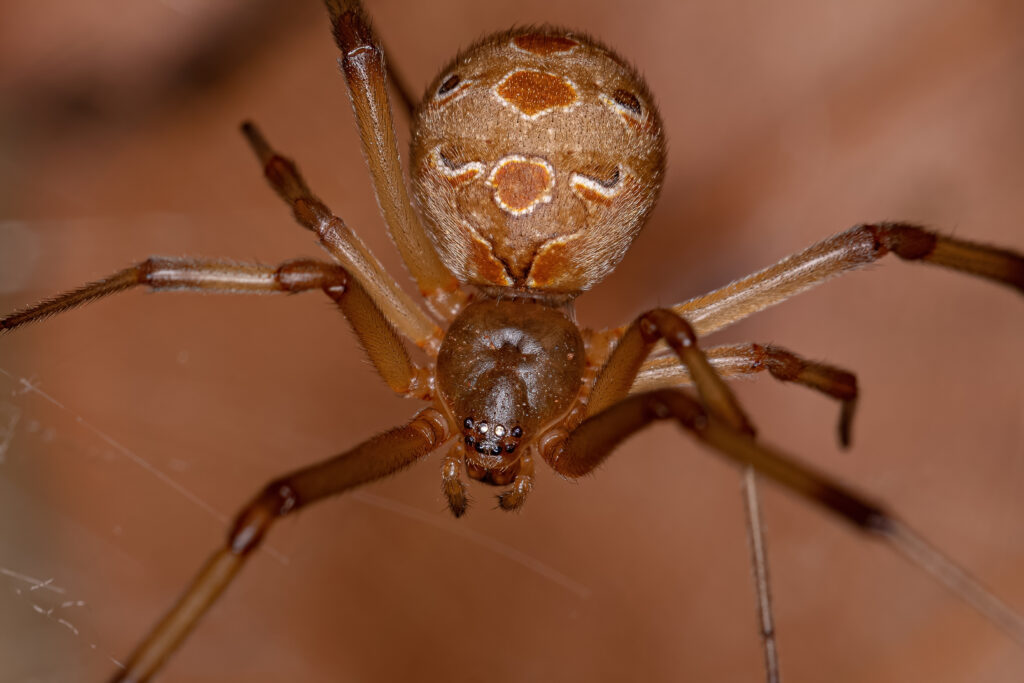
Brown widows belong to the genus
Latrodectus, like southern black widows. While their venom is toxic and can cause uncomfortable symptoms, it is far less dangerous than its cousin.
©iStock.com/ViniSouza128
The brown widow spider (Latrodectus geometricus), is a distinctive member of the widow spider family, known for its unique physical characteristics. Unlike the glossy black appearance of black widows, the brown widow typically has a tan to light brown coloration, with a distinct, often orange to yellow, hourglass-shaped marking on the underside of its abdomen. Another key distinguishing feature is the presence of lighter, geometric patterns on its dorsal abdomen, which may resemble a series of hourglasses or bars, hence its scientific name. Brown widows are generally smaller than their black widow relatives, with a body length ranging from 8 to 15 millimeters. Their legs are adorned with dark and light bands.
The brown widow spider is venomous, like other widow spiders, but its venom is considered less potent than that of the black widow. While brown widow bites can cause symptoms such as localized pain, swelling, and discomfort, they are usually milder and rarely result in severe medical complications. The brown widow is generally less aggressive than black widows and is known to bite less frequently when disturbed, which contributes to its reputation as a less dangerous spider.
Distribution
Brown widow spiders have a worldwide distribution. Originally native to South Africa, they have become established populations in regions beyond their native range due to global trade and human transportation. Brown widows can now be found in the southeastern United States, particularly in Florida, as well as in California, Hawaii, and other southern states. They have also been reported in parts of Europe, Asia, and the Caribbean. This adaptability to a range of climates and environments has contributed to their extensive distribution and makes them a notable and successful invasive species in many regions.
#5 Redback Spiders
Description
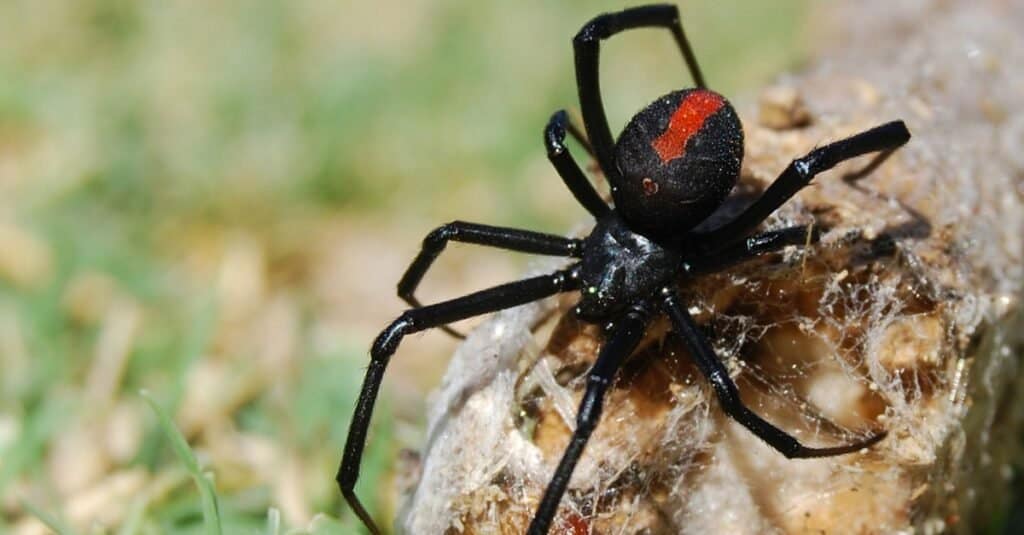
The poisonous Australian redback spider bites can, on rare occasions, be deadly.
©iStock.com/maria72
Redback spiders (Latrodectus hasseltii) are members of the widow spider family and share several similarities with black widows. Redbacks are typically small to medium-sized, with females measuring around 1 centimeter in body length, while males are significantly smaller. Their most distinguishing feature is the prominent red or orange hourglass-shaped marking on the dorsal side of the abdomen. This red hourglass is a key identifier, in contrast to the red markings found on the ventral side of the more dangerous southern black widows. The rest of the spider’s body is usually black or dark brown, and they have long, slender legs.
Redback spiders are indeed venomous, like their black widow relatives. Their venom contains neurotoxins that can cause severe pain, muscle cramps, nausea, and sweating in humans when bitten. While redback spider bites can be painful and distressing, fatalities are extremely rare, thanks to the availability of antivenom and prompt medical treatment. Unlike black widows, redback spiders are known to spin messy, irregular webs in sheltered locations, such as under rocks, in crevices, or in human-made structures, rather than the classic, organized orb-shaped webs.
Distribution
Redback spiders primarily live in Australia, and their distribution spans across most of the continent. They are particularly prevalent in urban and suburban areas, where they inhabit dark, sheltered locations such as garages, sheds, and outdoor toilets. While their native range is in Australia, redback spiders have been inadvertently introduced to some other countries, including New Zealand and Japan, although they remain less common in these regions.
#6 Barn Funnel Weavers
Description
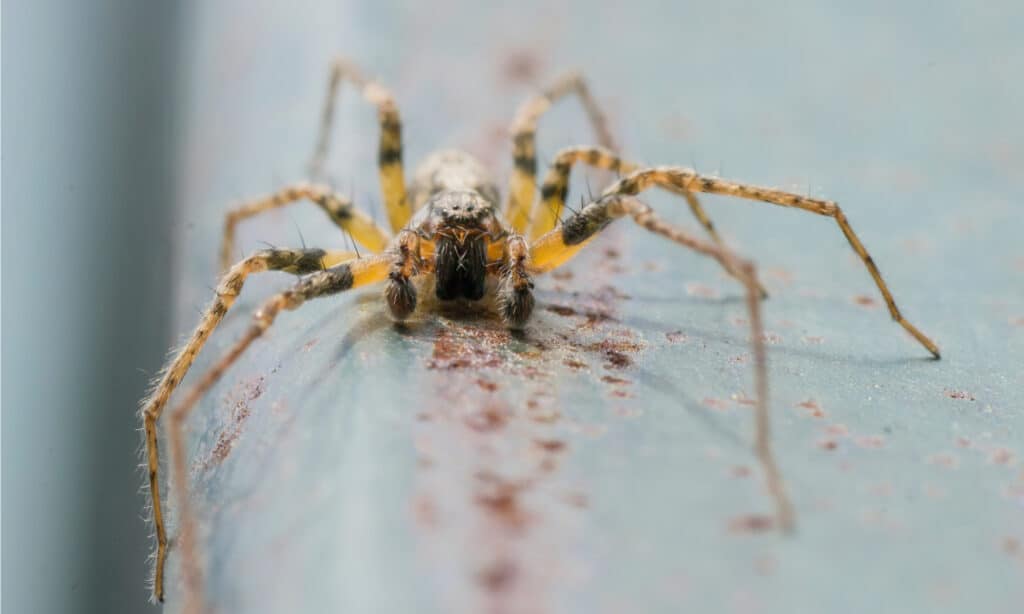
Barn funnel weavers lack red markings on their abdomen.
©Korovko Gleb/Shutterstock.com
The barn funnel weaver (Tegenaria domestica) is typically small to medium-sized. Its body length ranges from 6 to 20 millimeters. Barn funnel weavers have elongated, slender bodies with light brown to grayish coloration and often display a series of chevron-like markings on their abdomen. Unlike the shiny black appearance of black widows and their distinctive red or orange hourglass markings, barn funnel weavers lack such vivid markings.
In terms of venom, barn funnel weavers are venomous but are not dangerous to humans. Their venom is primarily used to immobilize and digest their prey, which consists of insects and other small arthropods. While their bites may cause mild discomfort, redness, and swelling, they do not result in serious medical complications. These spiders are generally non-aggressive and are more likely to retreat when approached by humans.
Distribution
Barn funnel weavers are widespread across North America, Europe, and parts of Asia. They are commonly encountered in temperate regions, where they inhabit a variety of man-made structures and natural environments. Barn funnel weavers often thrive in human dwellings, including houses, barns, and sheds, where they construct their funnel-shaped webs in corners and crevices to capture prey. Their adaptability to urban and rural settings has contributed to their widespread distribution, making them a familiar and harmless presence in many parts of the world.
Summary of 6 Spiders That Look Like Black Widows, But Are Not
| Rank | Name | Key Difference From Black Widow | Distribution |
|---|---|---|---|
| 1 | Noble false widow | Cream color abdominal markings | -Canary Islands (native) -Parts of Europe |
| 2 | False black widow | Reddish-orange abdomen | -Europe (native) -North America -South America -Australia -New Zealand |
| 3 | Red widow | Reddish-orange abdomen | -Florida, United States (native) |
| 4 | Brown widow | Light brown body and yellow hourglass abdominal marking | –Africa (native) -North America -Parts of Europe -Asia -The Caribbean |
| 5 | Redback spider | Red hourglass markings on dorsal abdomen (not on ventral side) | -Australia (native) |
| 6 | Barn funnel weaver | Light brown body with chevron markings | -Europe (native) -Parts of Asia (native) -North America |
The photo featured at the top of this post is © KarenGiblettPhotography/Shutterstock.com
Thank you for reading! Have some feedback for us? Contact the AZ Animals editorial team.







